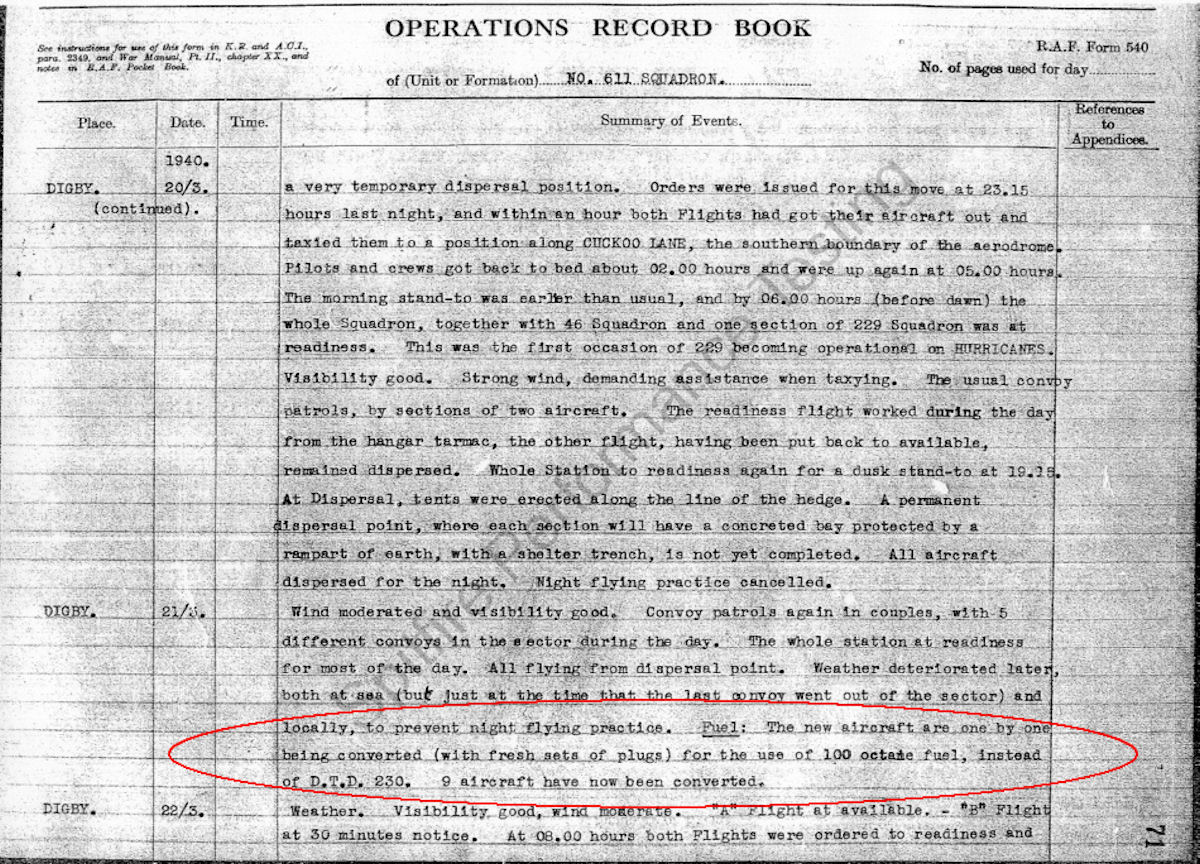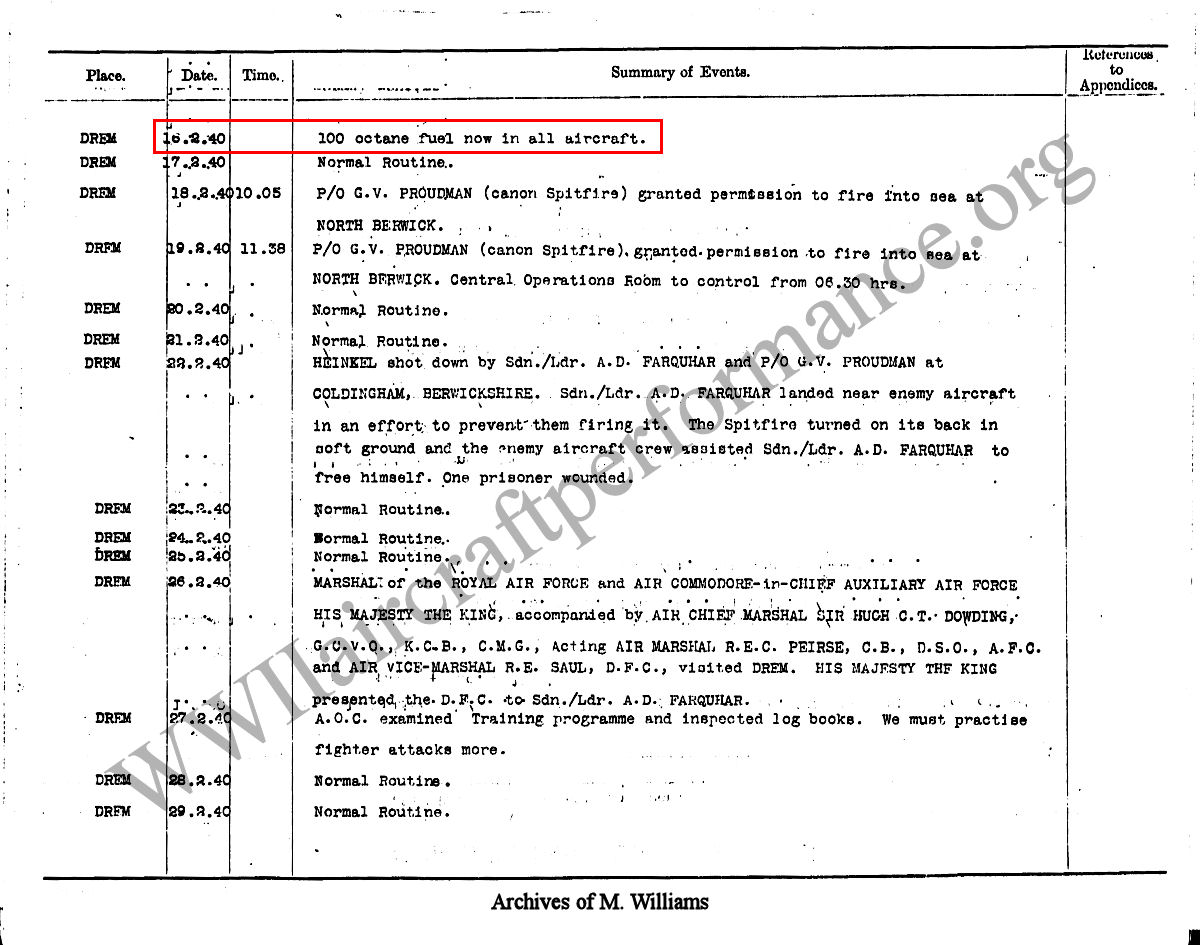
 |
|
|||||||
| FM/DM threads Everything about FM/DM in CoD |
 |
|
|
Thread Tools | Display Modes |
|
|
|
#1
|
||||
|
||||
|
Quote:
Quote:
Its no more than an awfully silly theory that when pilots made reference to emergency power, they meant using an emergency power far above the sanctioned limits for emergency power. In contrast 41Sqn_Banks has the theory that a reference to emergency boost *MUST* refer to +12 lbs, even though +12 lbs is not listed anywhere, not referred to by any pilot, report or manual. I'd like to see the reasoning why it is so certain that a reference to the emergency rating refers to a higher than +9 lbs boost. I call it wishful thinking. What he didn't came up is an explanation why would the Spitfire II manual lists +9 lbs as maximum combat boost (whereas the Spitfire I manual lists +12 lbs.) Quote:
It's simply your assumption that the mention of emergency boost or cut out refers to +12 lbs. My assumption is that emergency boost simply refers to the +9 lbs combat limit, which is underlined by the fact that this is the limit specified by the manual. You are welcome to prove that emergency boost allowed for greater than +9 lbs, in the summer of 1940. Quote:
There's a logical failure in your assumption that the boost cut-out would increase boost beyond +9 lbs. Its quite likely in fact that the pilots obtained +9 by using the boost cut-out, as on the Spitfire I. Fact is that the Spitfire I manual of the era lists +12 as the limit, obtainable with the boost cut-out. When Spitfire I pilots refer to using the boost, they sometimes specify the boost used as well (+12). Its only logical that since the the Spitfire II manual of the era lists in contrast only +9 as the limit, it would mean that when Spitfire II pilots refer to using the +9 boost, w/o specifing the boost used and referring it in vague terms like 'emergency boost'. P.S. Curious, isn't it, that there's not a single hint or tests for +12 Spitfire IIs isn't it. But if we are going down the road of fantasy boosts that are much higher than the limits listed in the engine/aircraft manuals, I want my 1.7 ata 109E, too. Even though if the manuals say something completely different. Hell if official limits are to be ignored on Spitfires, we might as well ignore them on Messerschmitts as well, and come up with whatever fantasy we may like.
__________________
Il-2Bugtracker: Feature #200: Missing 100 octane subtypes of Bf 109E and Bf 110C http://www.il2bugtracker.com/issues/200 Il-2Bugtracker: Bug #415: Spitfire Mk I, Ia, and Mk II: Stability and Control http://www.il2bugtracker.com/issues/415 Kurfürst - Your resource site on Bf 109 performance! http://kurfurst.org 
Last edited by Kurfürst; 06-09-2012 at 01:40 PM. |
|
#2
|
|||
|
|||
|
Kurfürst I'm not saying it was +12 boost, only that the boost must have been higher than +9, as it wouldn't make sense to use the cut-out without getting any benefit. I don't think there is so far any definite proof for the exact emergency boost value of the Spitfire II in 1940. However the fact that earlier (Merlin III), similar (Merlin XX) and later (Merlin 45) engines had +12 emergency boost in 1940 (the Merlin 45 of course in 1941), and the fact that +12 boost is documented for the Merlin XII for 1942(?) is a strong indicator that +12 boost was the emergency limitation of the Merlin XII.
BTW in RAF terminology "All-out" is not equal to "emergency". This can be seen in the Spitfire V test report: http://www.spitfireperformance.com/aa878.html Quote:
|
|
#3
|
|||
|
|||
|
Quote:
It does beg the question, what kind of boost control override installation is being described in the July 1940 Spit II manual? An original type, which gives full throttle plate control in the event of controller failure and is unsuitable as a combat boost? Or the modified type, which is not really a cutout but an increment for the boost control setpoint (to +12psi)?. The July 1940 manual does not let us know. It seems commonsense that the Spit II boost cutout was the +12psi type, and use of it as combat boost was approved and occurred during the BoB (although not in the July 1940 manual). This is considering the use of +12psi Spit I's during the same period and combat reports as above. But specific documents appear to be lacking. camber |
|
#4
|
|||
|
|||
|
Quote:
I also think it yould be strangeif one called something an "emergency boost" that you can use for 30 mins? Zach |
|
#5
|
|||
|
|||
|
Quote:
Sorry for OT, maybe one of the moderators can move the posts into FM subforum. |
|
#6
|
|||
|
|||
|
Here's a couple more RAF Hurricane squadron Operations Record Books that mention 100 octane fuel.
 
|
|
#7
|
|||
|
|||
|
Which says that it was tested and later that it wasn´t avaiable...
|
|
#8
|
||||
|
||||
|
Hmmmm, no 100 octane at Shawberry. Shawberry!!!!! Well, there you have it, then. (He misspelled "octane" as well, another indicator that this whole 100 octane thing is a hoax).
Good catch!
__________________

|
|
#9
|
|||
|
|||
|
When viewed in context the picture is clearer. Other units and stations at the time were clearly doing quite a bit more than "tested" 100 octane:
151 Squadron  611 Squadron  74 Squadron  605 Squadron left Hawkinge on 28 May 1940 where 100 octane was obviously present enroute to Drem, also which obviously had 100 octane. For some reason they stopped over at Shawbury, which I understand was a Flying Training School and apparently didn't stock 100 octane ("unavailable"). It's interesting that it was determined that the Squadron was unable to proceed further without the 100 octane fuel. This suggests that once having converted to 100 octane, whatever fuel the flying school was using (87 octane?) was unsuitable. 610 Squadron Spitfire Mk I at Hawkinge in early July 1940. Note the petrol bowser marked for 100 octane fuel.  100 octane was required at Drem, 605 Squadron's destination, as well as Debden where 504 Squadron was based.  Obviously Drem was stocked with 100 octane fuel by February 1940 602 Squadron  Fighter Station, With the Spitfires in Scotland. Flight, No. 1631 Vol. XXXVII, March 28, 1940 (602 Squadron at Drem) 111 Squadron 
Last edited by lane; 06-09-2012 at 10:09 PM. |
|
#10
|
|||
|
|||
|
Quote:
(reminds me awfully of the 150 grade tale
__________________
Il-2Bugtracker: Feature #200: Missing 100 octane subtypes of Bf 109E and Bf 110C http://www.il2bugtracker.com/issues/200 Il-2Bugtracker: Bug #415: Spitfire Mk I, Ia, and Mk II: Stability and Control http://www.il2bugtracker.com/issues/415 Kurfürst - Your resource site on Bf 109 performance! http://kurfurst.org 
|
 |
|
|